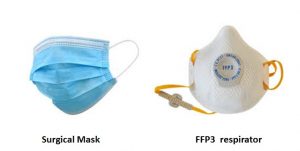3rd April 2020 – Are Face Masks Useful Against the Spread of COVID-19?
A Blog by Dr David J Flavell PhD FRCPath
Charity & Scientific Director of Leukaemia Busters
3rd April 2020
Unmasking the Myths

Just today (3rd April 2020) we heard Professor Jonathan van Tam at the 5 pm No 10 briefing update on Coronavirus tell us that there was no evidence that wearing a face mask reduced the transmission of infection. I strongly disagree with that view and I think the government advice on wearing face masks is likely to change over the coming days and weeks. Let me explain why.
It is true that a standard paper mask or a surgical mask made from synthetic materials offers only limited protection to the wearer firstly because this type of mask does not seal around the face but also because the coronavirus might be small enough to pass through the pores in the paper or other material from which the mask is made. There are other types of mask that do seal around the face and do exclude the virus therefore offering significant protection against infection and I’ll talk about these towards the end of this blog.
Don’t therefore expect a standard paper or surgical mask to fully protect you from the virus, it won’t. However, such masks still do present a barrier, albeit an imperfect one between your mouth, nose and the outside world. I believe that there is an advantage to wearing even this type of mask when the person wearing it is an asymptomatic carrier or is walking around with mild symptoms disregarding the order to stay at home. Remember this type of individual could be in the supermarket or at the petrol station in relative close proximity to other non-infected individuals.
So what is my rationale to suggest that in this situation a standard paper or surgical mask may help reduce the infection transmission rate?
It’s quite simple really, it’s not rocket science and is something which people working in medicine have been aware of for many decades, it is the simple barrier effect that a mask, any mask offers. When we cough or sneeze the spray that carries viruses and other pathogens as an aerosol emerges from our mouths and noses at speeds of up to 60 mph and can carry for distances of up to 8 metres making the government’s current 2 metres separation recommendation rather inadequate. Even when we talk we generate a continuous fine mist of saliva droplets that are un-noticed under normal circumstances.
The wearing of even an imperfectly sealed face mask would almost certainly reduce the spray carry distance whether from talking or from a full bodied sneeze and thus reduce the danger of spreading infection to bystanders. Vice versa and such a face mask would reduce the amount of aerosolised spray generated by others from reaching the mouth and nose of the wearer.
Now I’m not saying that wearing a standard face mask or surgical mask is going to completely eliminate the “escape” or “access” of potentially infectious droplets from the mouths and noses of infected individuals (who remember may not realise that they are infected themselves if asymptomatic) but it will certainly markedly attenuate the amount of virus that escapes into the open surrounding air and in so doing reduce the probability of infecting any bystander.
I admit that further studies are required to confirm this is the case with the current coronavirus but whilst there is uncertainty over this, why not err on the side of caution and wear a face mask whenever outside for the protection of those around us and ourselves? This makes good sense and my scientific intuition tells me that this would contribute to reducing the transmission rate.
I think it’s true to say that unlike many Asian countries there is a general cultural aversion in the UK and perhaps also in some other European countries and the US to wearing a face mask in public but I think that this has to change under the current circumstances for the very sound reasons I’ve highlighted above. If the pandemic continues on its current trajectory then I think the authorities in the UK will have to reconsider their advice as the WHO is currently reviewing.
It’s immaterial at this point in time whether or not there is firm evidence that face masks are beneficial. When there’s some uncertainty or the data is inconclusive or incomplete then the sensible thing to do is to fall on the side of caution and take the safer option whether this turns out later to be correct or not. That’s the way I look at it at least and I think anyone with a semblance of intelligence would have to agree.
There are also different standards of face mask ranging from the basic paper face masks made from paper to surgical masks made from synthetic water resistant materials all the way up to what are termed FFP3 respirator masks (known as N99 in the US) that are used in high risk situations by healthcare staff and scientists working with dangerous pathogens and chemicals. These are capable of excluding over 98% of particles the size of a coronavirus and importantly seal against the face unlike simple surgical masks.
We have used FFP3 respirator masks for many years in the Leukaemia Busters laboratories when handling hazardous chemicals or potentially infectious biological materials so we are well familiar with them in our routine work. These can be purchased by the public from various private manufacturers with and without a vent valve and undoubtedly they provide the highest level of protection to the wearer against droplet infection but also the valveless variety provides protection to others from a wearer who may be a carrier of the virus.
However, at this time FFP3 respirator masks are in very short supply now that there is high demand for them for use by front line hospital staff caring for COVID-19 patients. There should be serious consideration given to ensuring that FFP3 respirator masks are made available to everyone in the population when circumstances like this arise again in the future as surely they will due to this same coronavirus or to another novel zoonotic virus that has yet to emerge. This I believe would make all the difference to the rate of community spread when people are milling around outside whether shopping or just walking brushing past others.
For now until FFP3 respirator masks become widely available it seems that only standard paper and surgical face masks are the realistic option for the mass population but even these in my opinion would present a significant barrier effect thereby reducing the transmission rate.
I predict as the epidemic increases in the UK we will see more and more people electing to wear a face mask and that maybe the government’s advisers will eventually have to put aside their demand for definitive evidence that such masks have an impact on transmission and be forced to err on the side of caution just in case they’re wrong in their current view.
I’ve just learnt that the wearing of a face mask by anyone venturing out is to be made mandatory in New York. I would hope that the same will soon be true here and that the government and their advisers will cease being stubbornly against this when so much is at stake and when their judgement may not be incorrect as has been shown to be the case in the recent past with their earlier handling of this pandemic in the UK. Let’s try to avoid making any further mistakes and end up learning the lesson about face masks too late once again.


